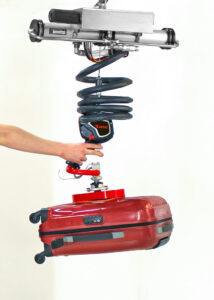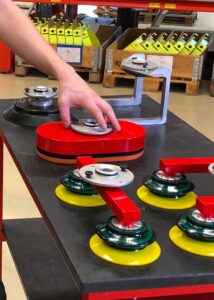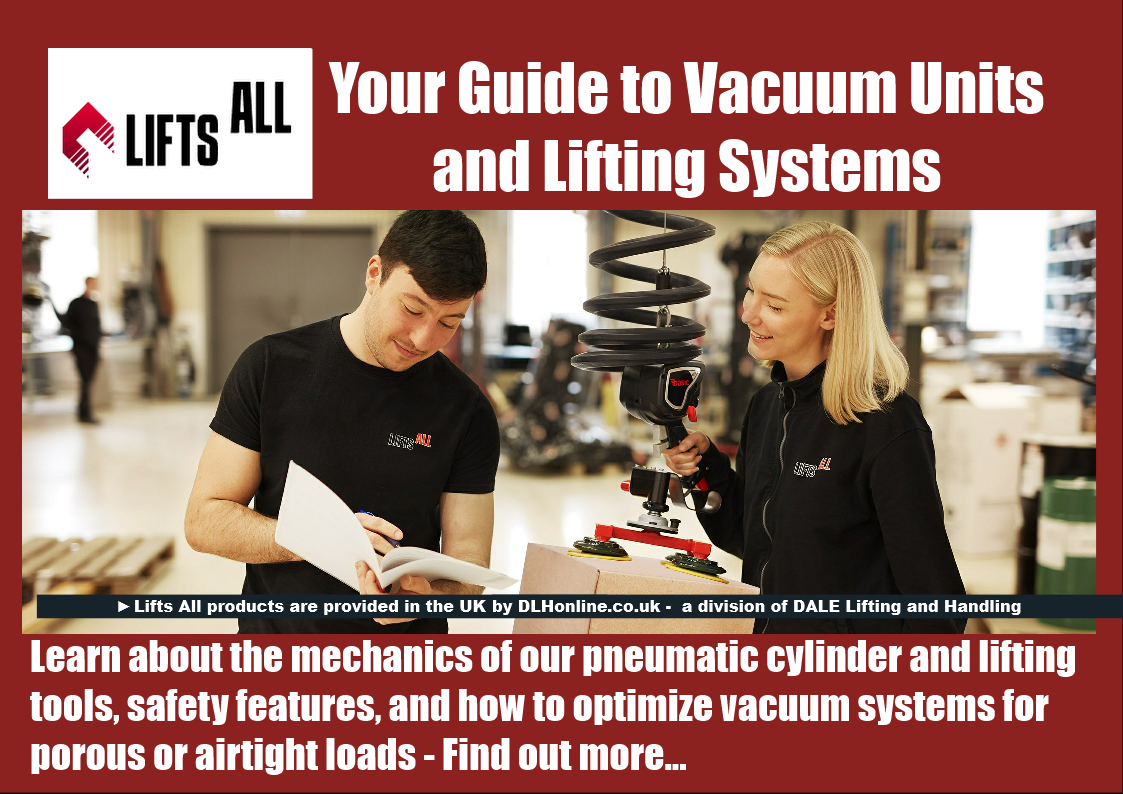Precision and safety are crucial when it comes to lifting and handling equipment. This guide from Lifts All outlines essential concepts related to vacuum technology, including absolute pressure and important units like bar and PSI. You will learn about the mechanics of our pneumatic cylinders and lifting tools, the safety features involved, and how to optimize vacuum systems for both porous and airtight loads. Whether you're selecting tools or working to maximize system efficiency, this guide provides the insights you need to explore vacuum-based lifting solutions.
Guide: Glossary, Units, and Scales for Vacuum
**Understanding Absolute Vacuum and Vacuum Pressure**
An absolute vacuum represents a space completely free of air, gases, and matter, resulting in a pressure measurement of zero. It's important to recognize that absolute pressure begins at this point of zero (absolute vacuum) and increases thereafter. This definition allows us to accurately measure pressure by combining the measured pressure with atmospheric pressure. Lifts All provides a helpful perspective on vacuum or negative pressure by expressing it as a percentage, where 0% corresponds to 1 atmosphere (1 Atm) or 1 bar. For instance, a vacuum reading of 40% translates to approximately -0.4 bar, while a 60% vacuum level corresponds to about -0.6 bar. This approach makes it easier to understand and visualize the degree of vacuum present.
**Exploring Atmosphere (Atm)**
The unit of pressure known as an atmosphere (Atm) is widely used, particularly in fields like hydraulics. One atmosphere equals the average air pressure experienced at sea level at a temperature of 15 degrees Celsius (59 degrees Fahrenheit), specifically measured at 101,325 kilopascals (kPa) or 101,325 pascals (Pa). Using standard atmospheric pressure as a foundational reference point is vital for various pressure measurements, including Torr and mmHg. This understanding is crucial for differentiating between varying levels of pressure and vacuum states, enhancing our ability to work with these concepts effectively.
Bar
Bar is a unit of pressure used in meteorology, high-pressure hydraulics, and diving. Lifts All’s lifting tools typically operate at 6-7 bar of compressed air. 1 bar ≈ 1 Atm, and 1 bar = 760 mmHg.
Gauge Pressure
By pumping air into an object, you add more air molecules than in the surrounding air. The pump compresses the air into the object, creating gauge pressure, which is measured relative to ambient atmospheric pressure. Understanding vacuum levels in different units such as Torr, mbar, and Pascal is crucial for technicians monitoring vacuum systems, as inconsistent pressure measurements can significantly affect system performance and user perceptions.
Micro
The term "micro" refers to a metric prefix used to denote units.
Millimetres of Mercury (mmHg) and Inches of Mercury
Vacuum pressure is commonly measured in millimeters of mercury (mmHg) or inches of mercury on the pressure scale. This measurement is used in various applications, including scientific research, industrial processes, and medical devices, to ensure precise control and standardization.
Pascal (Pa)
Vacuum pressure is commonly measured in millimeters of mercury (mmHg) or inches of mercury on the pressure scale. This measurement is used in various applications, including scientific research, industrial processes, and medical devices, to ensure precise control and standardization.
PSI (Pounds per Square Inch)
PSI is a unit of pressure commonly used in the United States. One bar is equivalent to 14 psi.
SI Units
SI units are standardized units of measurement that are used internationally to quantify various values.
Torr
Torr, or millimeters of mercury (mmHg), is a unit of pressure. While there is a slight difference between Torr and mmHg, it is negligible. This unit is commonly used for measuring vacuum pressure or blood pressure in healthcare settings.healthcare settings.
______________________________________________________________________________________________________________
Pneumatic Lifting System – Lifting with Compressed Air and Vacuum Systems
Bal-Trol
Bal-Trol’ is the pneumatic cylinder that powers nearly all of Lifts All’s lifting tools. It consists of an aluminum cylinder with an encapsulated single-acting piston anchored to a cable. Compressed air is applied to one end of the Bal-Trol, while the other end remains at atmospheric pressure. When air is supplied, the piston moves back and forth, raising the lifting tool as air is introduced and lowering it as air is released. The lifting force is directly proportional to the air pressure, for example, a 10% increase in pressure yields a 10% increase in lifting power. The standard operating pressure for Bal-Trol is 6 bar, with a tolerance of +20%.The Bal-Trol piston rests against a cushion of air in the cylinder. This air cushion allows certain flexibility for manual adjustments to the height of the lifting tool, which is practical for precise positioning and unlike traditional electric hoists that are static.
Anti-Jump
The Bal-Trol features a check valve, or anti-jump mechanism, controlled by a spring that adjusts the preload. If the load on a lifting tool is intentionally or unintentionally knocked off, excess airflow to the Bal-Trol piston will cause the tool to jump upwards. In this case, the check valve closes, the spring no longer resists the flow, and pressure builds up to stop the tool’s upward jostle.
Load Guard
The load guard is a valve that gauges the pressure in the cylinder, calibrated slightly above what the gripper exerts in the Bal-Trol. When a load is lifted, the pressure rises triggering the load guard to disconnect airflow to the ‘release’ button. This safety feature ensures that the load cannot be released while suspended in the air. When the load is placed down, the pressure drops, allowing airflow back into the ‘release button and the operator can then release the load.
Lifting Safety System
The load guard regulates the Bal-Trol’s Lifting Safety system. Mechanical grippers are equipped with a sensor to confirm that the load is secure, while vacuum grippers have a vacuum sensor to detect when the tool has reached a specific vacuum level upon attachment. Only then can the load be lifted. If the operator attempts to lift without receiving a green-light signal from the load guard, airflow to the PSH control is cut off, disabling the ‘up’ lever and allowing only downward movement.
________________________________________________________________________________________________________________________

Vacuum Gripping
When designing a vacuum-based lifting system, it’s important to adapt the tool to the object being lifted. Lifts All’s lifting tools or grippers can lift either with mechanical means, vacuum cups, or a combination of both. The following section focuses on lifting with vacuum-based grippers.
What is Vacuum and How is it Measured?
Vacuum occurs when the pressure is lower than atmospheric pressure. To achieve this, air must be removed using a vacuum pump. The evacuated air per unit of time is known as vacuum flow and is a measurement of the pump’s efficiency. To determine the vacuum level, the negative pressure is measured in the vacuum cup or vacuum application.
Porous vs. Airtight Loads
The vacuum pump creates a vacuum flow in the suction cups by expelling the air inside, while atmospheric pressure pushes the cup downward, securing it to the object. When suction cups are placed on to a load made of porous material, some air will always seep through, preventing complete expulsion of air. In these cases, a vacuum pump with higher capacity is required to offset the continuous air leakage.
For airtight objects, the pump’s capacity is dependent on how quickly it can expel air to achieve a specific vacuum level. Effective lifting depends on choosing the right suction cups – type, size, and number – and choosing an appropriate ejector. The surface area covered by the vacuum cups is crucial for safe gripping.
Want to see more?
CLICK HERE to view the Lifts All range of vacuum lifters and mechanical grippers
Need Help?
Call us on 0161 223 1990 or Email sales@dale-lifting.co.uk



